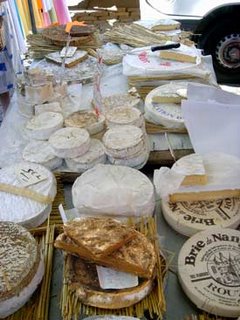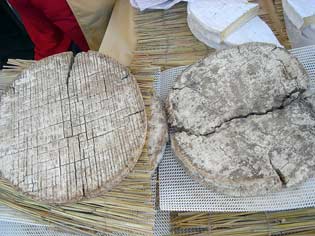 For a long time now I have been following David's little promenades through the streets of my beloved Paris, enjoying with him the little idiosyncrasies that make up that beautiful city, savouring with him the flavours and tastes and aromas of the City of Light. Flavours.... tastes......aromas..... Ah the memories! Many years ago when I had the good fortune to live and work in Paris, my gorgeous little abode was two floors up from a cremerie -- a little cheese shop run by M. et Mme LeComte, and from the moment I woke up in the morning to cock crow (yes! believe it! In the heart of Paris!) to the moment my head hit the pillow at night, I had the strong smell of a range of the more than 365 cheese of France wafting past right under my nose.
For a long time now I have been following David's little promenades through the streets of my beloved Paris, enjoying with him the little idiosyncrasies that make up that beautiful city, savouring with him the flavours and tastes and aromas of the City of Light. Flavours.... tastes......aromas..... Ah the memories! Many years ago when I had the good fortune to live and work in Paris, my gorgeous little abode was two floors up from a cremerie -- a little cheese shop run by M. et Mme LeComte, and from the moment I woke up in the morning to cock crow (yes! believe it! In the heart of Paris!) to the moment my head hit the pillow at night, I had the strong smell of a range of the more than 365 cheese of France wafting past right under my nose.So, when I came across this not-so-cheesy little piece about one of those 365 French cheeses, I simply had to bring it here and share it with my readers.
In summertime, I follow Parisians who're making a mass exodus from the city. We scurry from the city, jamming crowded autoroutes and packing the train stations. The city offers few trees or shade, and the sunlight reflecting off the white buildings means little respite from the withering heat no matter how hard you look-and there's only so much icy-cold rosé that I can drink!
So I often make weekend trips to the village of Coulommiers, where there's a lively outdoor market selling the most famous cheese in the world: Brie.
Brie is not a town, but a region to the east about one hour away by car or train. The sunday market in Coulommiers is one of my favorites because no where else in the world will you find so many cheese vendors selling all kinds of Brie, many unavailable anywhere else.
There are two true Brie cheeses. The classic is Brie de Meaux, about 14-inches across, each disk weighing approximately 5 pounds. Brie de Melun is slightly smaller, a tad higher, and doesn't ripen all the way to make a creamy pâte, like Brie de Meaux. Often you'll cut open Brie de Melun and discover a drier layer of underripe cheese in the middle. These cheeses have the most superb flavor in the late spring-to-early summer, when the cows feast on mustard blossoms, giving the cheese a musty, complex flavor and slight golden tinge.
Brie de Melun is aged longer than Brie de Meaux. It has a firmer texture and many aficionados prefer it because of it's stronger and more aggressive flavor. Both cheeses can be made with raw or pasteurized milk, although I prefer the raw versions, which are rarely available in the United States due to regulations in the US (where you're allowed to drive at high-speeds on freeways while talking on a cell phone and drinking a giant latté, but prohibited from eating cheese that has been prepared the same way for centuries.)
These two Brie cheeses are AOC (Appellation d'Origine Contrôlée) as of 1990, a product designation given by the French authorities, which states that these specific cheeses meet certain criterion for heating, coagulating, and salting the milk, the subsequent ripening, as well as being fabricated within the specific region. Most cheeses you'll find labeled Brie are not a true Brie unless the AOC label is affixed to the exterior. In the US, you'll only find it at a specialty cheese store...if you're lucky to find it at all. In France, a notable exception is Brie de Nangis, which is a young, milder Brie from the region but does not carry the AOC label, but it's good. The AOC designation has also been given to 34 cheeses as well as other products like the tasty green lentils from Puy, Haricot Tarbais (the dried beans used to make cassoulet), and the free-range Poulet de Bresse.
Although AOC is often a sign of quality, other products don't carry the appellation, since they may be made in a neighboring region, or a slightly larger size, or stirred a few more times than the regulations allow during production. So as with anything, let your nose and the taste be your guide. No matter where you live, always seek out a good cheese shop and ask the fromager for advice: they're a wealth of knowledge and should be proud of their cheeses and happy to help you.
Coulommiers is another excellent cheese from the region, and not AOC. It's a smaller round, about 6-inches in diameter, and not widely known outside of France. Coulommiers has the same barnyard-like smell that is delectably appetizing in Camembert and indicative of a truly ripe Brie, but is a bit more pungent.
Locals in Brie are perhaps the only ones who have developed an appreciation for Brie Noir. Normally Brie cheeses are ripened for between one and two months. Brie Noir is ripened much longer, often 8 to 10 months. It's such a regional specialty, and only appreciated by people of the region, that you're likely never to see it anywhere else.
As you can see, Brie Noir is dark, brown, and crumbly. It's covered with dusty powder and it tastes, well...horrid. After my first eaglerly-anticipated bite, I could not get the vile taste out of my mouth. It's bitter and acidic. A friend from Coulommiers suggested I dip it into my café au lait at breakfast, which I suspiciously tried, which actually moderated the flavor and made it more palatable. Who knew?
Brie Q & A's
Q:But my supermarket cheese says Brie...isn't that Brie?
A:Real Brie is almost always Brie de Melun or Brie de Meaux. Most of the other cheeses labeled 'Brie' are not true Brie. They often won't ripen properly and taste worlds apart from real Brie.
Q:Should you eat the rind?
A:The general rule for eating the rind of any cheese is that you may eat it as long as it won't interfere with the taste or experience of the cheese. For example, something with a lot of mold growth obviously wouldn't taste very good. A tough rind, like the rind of Parmesan, you wouldn't want to eat either.
Q:How do I cut Brie?
A:Think of any round wheel of cheese like a pie or cake. You should slice a triangular wedge out, so that you have a nice portion of cheese.
When presented with a full cheese plate to serve yourself, never cut the 'nose' off the cheese, the pointy end: It's very bad manners!
Photographs: David Lebovitz
Click on Link:
Chateau Lalinde : The perfect venue for your event
TAGS: Events Rent a chateau France
Chateau
Perigord Food Holidays in France Recipes







